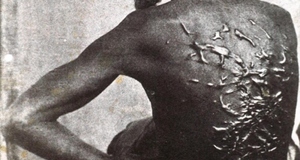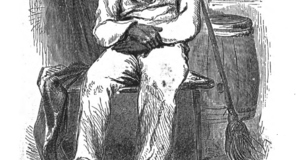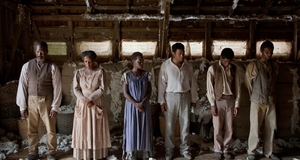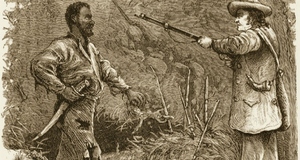Colonial-era fictional and non-fictional descriptions of slave motherhood offer conflicting accounts of the attitudes of slave mothers toward their children. While abolitionists tended to portray slave mothers as wholly selfless, doting, and maternal, pro-slavery writers described slave mothers as negligent and cruel. The debate over the nature of slave motherhood was especially relevant to the Caribbean, where brutal working conditions, disease, and malnutrition impeded slave reproduction. Plantation owners blamed slave women for their failure to reproduce, accusing them of practicing birth control and procuring abortions. In some cases, planters accused slave women of committing infanticide.
It is difficult to ascertain just how often the latter occurred. There is certainly evidence to suggest that Caribbean planters’ allegations of slave women killing their infants were exaggerated. On the other hand, “the infant mortality rate from natural causes was undoubtedly high in the Caribbean, but the unusually high death rate within the first week, not satisfactorily explained as caused by tetanus, may signify that women used preparations which effected apparently natural death.” One of the more famous stories of slave infanticide in the Caribbean is that of Sabina Park, a Jamaican slave who was brought to trial for killing her young child. Park claimed that she “had worked enough for buckra (master) already and that she would not be plagued to raise the child… to work for white people.”
The obvious response to slave infanticide is to conceptualize it as an act of desperation, a sad act, or an act of altruism, in the sense that it was intended to save enslaved children from a life of hard labor, degradation, and physical, sexual, and mental abuse.
But what if slave infanticide, in all its horror, was an expression of resistance? To conceptualize it this way places agency back in the hands of the slave women who killed their children, because it assumes that their decision was actively, discursively antagonistic and insurrectionary.
Reactions to slave infanticide varied according to one’s beliefs about the nature of slaves and the justice of slaveholding. According to Christopher Peterson, “for racist ideologues, slave infanticide is further proof of an animality inherent in black motherhood: a propensity to violence from which white motherhood is exempt. For abolitionists, [it] emerges both as proof of slavery’s evils and of a mother’s love for her children.” Indeed, in keeping with the viewpoint Peterson attributes to abolitionists, the obvious response to slave infanticide is to conceptualize it as an act of desperation, a sad act (which it certainly was), or an act of altruism—altruism in the sense that it was intended to save enslaved children from a life of hard labor, degradation, and physical, sexual, and mental abuse. But what if slave infanticide, in all its horror, was an expression of resistance? To conceptualize it this way places agency back in the hands of the slave women who killed their children, because it assumes that their decision was actively, discursively antagonistic and insurrectionary.
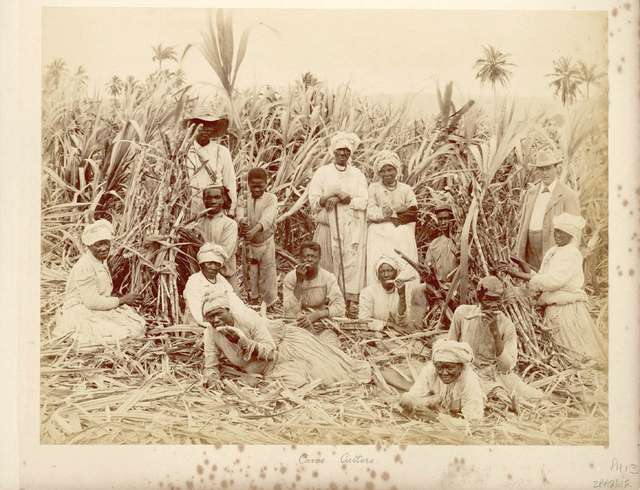
An image depicting cane cutters in Jamaica after formal slavery was ended, mid-19th century. More than half of the slaves in the region were female.
The extremely grave nature of this subject matter merits an unusually high degree of respect and sensitivity in one’s approach to it. History is not a neutral discipline. Considering infanticide as a form of resistance is important in telling the story of Caribbean slave women as full people, as rational actors who made calculated decisions with rebellion in mind. Drawing on colonial-era accounts of slave motherhood, resistance theory, and recent work on the sociology of slavery, the central aim of this paper is to explore the equation of infanticide with resistance, with a geographical focus on the colonies of Jamaica, Barbados, and Saint-Domingue. All of the historical sources cited are from the mid-eighteenth century to 1834, when Britain abolished slavery in its colonies. Sources pertaining to Saint-Domingue are from prior to the slave rebellion of 1791 that culminated in the abolition of slavery in the colony.
Considering infanticide as a form of resistance is important in telling the story of Caribbean slave women as full people, as rational actors who made calculated decisions with rebellion in mind.
Extant accounts of Caribbean slave life are rife with racist assumptions about the supposed negligence and selfishness of black mothers. For example, many plantation owners accused slave women of procuring abortions with the intention of continuing to have promiscuous sex, unhindered by pregnancy. White observers such as plantation owners, overseers, and doctors believed that slave women’s alleged promiscuity made them especially prone to venereal disease. They often blamed slave miscarriages on the medicines slave women took (or supposedly took) to treat venereal disease. The logical implication of this belief was that if slave women were not so sexually indiscriminate, they would not need to take miscarriage-inducing medicines. Indeed, plantation owners found it more convenient to blame slave women for their failure to produce healthy offspring than to accept responsibility for the deplorable conditions that undoubtedly contributed to complications in pregnancy and childbirth. Physicians in Saint-Domingue accused slave mothers of causing mal de mâchoir (or ‘soreness of the jaw,’ cases of which have been retrospectively diagnosed as tetanus and neonatal tetany) among infants. This, of course, functioned to bolster the claim that enslaved women were neglectful, evil, unfit mothers. According to the French author of a 1790 pro-slavery pamphlet, they “destroy their own fruit, or they practice infanticide in order to live without moderation.”
These derogatory cultural images of enslaved mothers are relevant to the analysis of slave infanticide because they colored white people’s perception of slaves’ reproductive habits. It was a difficult task, determining if a documented infanticide case was valid, and not a natural death caused by poor living conditions. As result, there is no clear consensus among historians on the issue. In 1796, a slave named Mary Thomas of the Newton Estate in Barbados was accused of killing her newborn infant. Historian Hilary McD. Beckles describes the event by restating Wood’s claim that Mary Thomas killed her infant out of anger at her white lover, the plantation bookkeeper. Beckles does not question Woods in this paraphrased account. Conversely, in her summary of the Mary Thomas case, historian Tara A. Inniss casts doubt on Wood’s accusation of infanticide, adding, “Enslaved midwives were easy targets for blame should the child succumb to illness or sudden death in the first days of life.” Inniss and Beckles’ differing interpretations of Wood’s account demonstrate the challenge of discerning fact from fiction in records of infanticide. It is almost impossible to tell if Mary Thomas was in fact guilty of killing her infant.
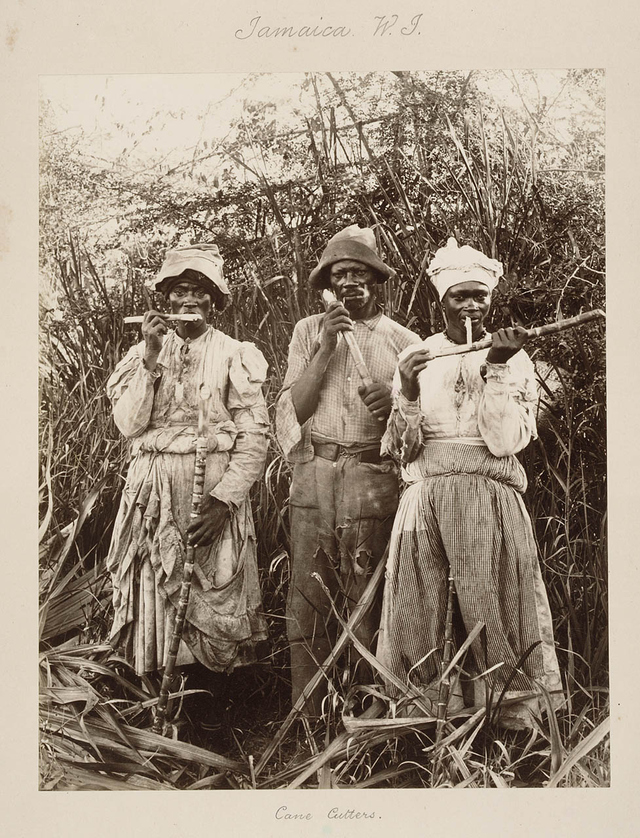
Even those who believe that slave infanticide was common admit that this supposition is based on some speculation. In the words of Barbara Bush, who has written extensively on gender and slavery in the Caribbean, studying Caribbean slave infanticide requires “informed speculation and creative approaches in history.” A perfect example of such a speculative, creative approach lies in James A. Delle’s analysis of birth and death records of the Radnor Plantation in Jamaica. Records from the years of 1822-1825 list eight infant deaths for which the cause of death is unnoted. Delle speculates that some of these were infanticides. Bush is one of the more vocal proponents of the argument that slave women frequently practiced infanticide. In an articled titled “Hard Labour: Women, Childbirth and Resistance in British Caribbean Slave Societies,” she notes that Caribbean populations grew significantly after emancipation, even though the standard of living hardly improved in most places. To her, this indicates that the “nature of slavery and the responses of slave women to their bondage must also be considered.” Bush notes that slave infanticide occurred in the antebellum United States, where slaves lived under generally better conditions than in the Caribbean. Thus, it was probably also practiced in the Caribbean. This statement is supported by the fact that, in general, Caribbean slave populations were more successful than those in the United States in preserving parts of West African cultural traditions. In many traditional West African cultures, newborn babies are not considered fully human until eight days after birth. According to Bush, the possibility that slave women committed infanticide through “letting” their young infants die (as opposed to violently killing them) is likely.
Numerous books and articles on slavery in Saint-Domingue state that infanticide contributed to the colony’s low fertility rate but do not provide any concrete examples of recorded infanticides. Londa L. Schiebinger’s Plants and Empire: Colonial Bioprospecting in the Atlantic World is a notable exception. Schiebinger cites a Saint-Domingue physician’s account of a woman who killed her two children to “steal them away from slavery and the discovery of the bodies of thirty-one infants at a Saint-Domingue plantation, some of which had most likely been killed. On the same plantation where the bodies were discovered, an infant said to have died of tetanus was found to have a ball of “vegetable matter” stuffed in its throat. On another Saint-Domingue plantation, a midwife admitted to killing seventy newborn babies. “See if I deserve death!” she reportedly said. “It is a shameful custom to raise children into slavery.” Reports of Jamaican slave infanticide include those found in the birth and death records of the Mesopotamia Plantation and the aforementioned Sabrina Park case.
In sum, the lack of large-scale data on the prevalence of slave infanticide in the British and French Caribbean makes it a difficult topic of study. Planters’ racist misconceptions about black female sexuality and motherhood taint the extant records to which historians have access, adding another layer of difficulty. Still, it is likely that just as in the United States, slave infanticide was not unknown in the Caribbean. Perhaps the significance of slave infanticide lies not in its frequency, but in the social meanings with which it was embedded. With that in mind, the next step in telling the story of infanticide in Barbados, Jamaica, and Saint-Domingue is discerning the meanings that slave women prescribed to the act of killing their infants.
Most of the scholarly literature on slave infanticide focuses on slavery in the antebellum United States. In this literature, recorded cases of infanticide are frequently dismissed as anomalies and followed by lengthy declarations of slave women’s maternal aptitude. The effect of this is to imply that infanticide excludes the possibility of parental love, and vice-versa. The truth is somewhat more complex. As Darlene Clark Hine and Kathleen Thompson explain in A Shining Thread of Hope: The History of Black Women in America, slaves’ statements on infanticide indicate that the killing of one’s children was often conceived of as an altruistic act and that enslaved women who killed their children often did so out of love.Continued on Next Page »
Bauer, Raymond A. and Alice H. Bauer. “Day to Day Resistance to Slavery.” In Rebellions, Resistance, and Runaways Within the Slave South, edited by Paul Finkelman, 84-115. New York and London: Garland Publishing, Inc., 1989. Originally published in Journal of Negro History 27 (1942): 388-419.
Beckles, Hilary McD. Natural Rebels: A Social History of Enslaved Black Women in Barbados. Rutgers, NJ: Rutgers University Press, 1989.
Brown, Vincent. “Spiritual Terror and Sacred Authority in Jamaican Slave Society.” Slavery and Abolition 24 (2003): 24-53.
Burnurd, Trevor. “The Sexual Life of an Eighteenth-Century Jamaican Slave Overseer.” In Sex and Sexuality in Early America, edited by Merril D. Smith, 163-189. New York: New York University Press, 1998.
Bush, Barbara. “Defiance or submission? The role of the slave woman in slave resistance in the British Caribbean.” Immigrants and Minorities 1 (1989): 16-38.
---. Slave Women in Caribbean Society: 1650-1838. Bloomington, Indiana: Indiana University Press, 1990.
Bush-Slimani, Barbara. “Hard Labour: Women, Childbirth and Resistance in British Caribbean Slave Societies.” In More Than Chattel: Black Women and Slavery in the Americas, edited by David Barry Gaspar and Darlene Clark Hine, 193-217. Bloomington and Indianapolis: Indiana University Press, 1996.
Camp, Stephanie M.H. Closer to Freedom: Enslaved Women and Everyday Resistance in the Plantation South. Chapel Hill: University of North Carolina Press, 2004.
Christian, Barbara. “Beloved, She’s Ours.” Narrative 5 (1997): 36-49.
Compton, Tonia M. “Infanticide.” In Encyclopedia of Slave Resistance and Rebellion, Volume 1: A-N, edited by Junnius P. Rodriguez, 259-263. Westport, CT and London: Greenwood Press 2007.
Delle, James A. “Women’s Lives and Labour on Radnor, a Jamaican Coffee Plantation, 1822-1826.” Caribbean Quarterly 54 (2008): 7-23.
Dunn, Richard S. “The Demographic Contrast between Slave Life in Jamaica and Virginia, 1760–1865.” Proceedings of the American Philosophical Society 151 (7007): 43-60.
Fox-Genovese, “Strategies and Forms of Resistance: Focus on Slave Women in the United States.” In In Resistance: Studies in African, Caribbean, and Afro-American History, ed. Gary Y. Okihiro, 143-165. Amherst: University of Massachusetts Press, 1986.
Hine, Diane Clark and Kathleen Thompson. A Shining Thread of Hope: The History of Black Women in America. New York: Broadway Books, 1998.
Inniss, Tara A. “‘Any Elderly, Sensible, Prudent Woman’: The Practice and Practitioners of Midwifery During Slavery in the British Caribbean,” in Health and Medicine in the Circum Caribbean, 1800-1968. Edited by Juanita De Barros, Steven Palmer and David Wright, 40-52. New York: Routledge, 2009.
McClellan, James E. Colonialism and Science: Saint Domingue and the Old Regime (Chicago: University of Chicago Press, 1992.
Morgan, Kenneth. “The Struggle for Survival: Slave Infant Mortality in the British Caribbean in the Late Eighteenth and Nineteenth Centuries.” In Children in Slavery Through the Ages, edited by Gwyn Campbell, Suzanne Miers, and Joseph C. Miller, 187-203. Athens, Ohio: Ohio University Press, 2009.
Mumford, Clarence J. The Black Ordeal of Slavery and Slave Trading in the French West Indies, 1625-1715, Volume III: Culture, Terror, Resistance. Lampeter, UK, Queenstown, ON, and Lewiston, NY: Edwin Mellen Press, 1991.
Patterson, Orlando. The Sociology of Slavery: An Analysis of the Origins, Development and Structure of Negro Slave Society in Jamaica. Cranbury, NJ: Associated University Presses, Inc., 1969.
Peterson, Christopher. “Beloved’s Claim.” Modern Fiction Studies 52 (2006): 548-569.
Popkin, Jeremy D. You Are All free: The Haitian Revolution and the Abolition of Slavery. New York: Cambridge University Press, 2010.
Schiebinger, Londa L. Plants and Empire: Colonial Bioprospecting in the Atlantic World. Cambridge, Harvard University Press, 2007.
Trouillot, Michel-Rolph. Silencing the Past: Power and the Production of History. Boston: Beacon Press, 1995.
Turiel, Elliot. “Resistance and Subversion in Everyday Life.” Journal of Moral Education 32 (2003): 115-130.
Weaver, Karol K. “‘She Crushed the Child’s Fragile Skull’: Disease, Infanticide, and Enslaved Women in Eighteenth-Century Saint-Domingue.” French Colonial History 5 (2004): 93-109.
White, Deborah Gray. Ar’n’t I a Woman? Female Slaves in the Plantation South. New York and London: W.W. Norton and Company, 1985.
Endnotes
1.) Kenneth Morgan, “The Struggle for Survival: Slave Infant Mortality in the British Caribbean in the Late Eighteenth and Nineteenth Centuries,” in Children in Slavery Through the Ages, eds. Gwyn Campbell, Suzanne Miers, and Joseph C. Miller, 187-203 (Athens, Ohio: Ohio University Press, 2009), 189, 191.
2.) Barbara Bush-Slimani, “Hard Labour: Women, Childbirth and Resistance in British Caribbean Slave Societies,” in More Than Chattel: Black Women and Slavery in the Americas, eds. David Barry Gaspar and Darlene Clark Hine (Bloomington and Indianapolis: Indiana University Press, 1996), 209.
3.) Orlando Patterson, The Sociology of Slavery: An Analysis of the Origins, Development and Structure of Negro Slave Society in Jamaica (Cranbury, NJ: Associated University Presses, Inc., 1969), 106.
4.) Christopher Peterson, “Beloved’s Claim,” Modern Fiction Studies 52 (2006), 553-554.
5.) The choice of these three colonies was made purely out of necessity, as accounts of slave infanticide in other parts of the Caribbean are extremely hard to come by.
6.) Barbara Bush, Slave Women in Caribbean Society: 1650-1838 (Bloomington, Indiana: Indiana University Press, 1990), 139-140. Although many slave women did have abortions, it is difficult to tell from the extant sources how many supposedly induced abortions were actually miscarriages.
7.) Bush-Slimani, “Hard Labour,” 202.
8.) Karol K. Weaver, “‘She Crushed the Child’s Fragile Skull’: Disease, Infanticide, and Enslaved Women in Colonial St. Domingue,” French Colonial History 4 (2004), 93-96.
9.) Weaver, “‘She Crushed the Child’s Fragile Skull,’” 101, 102.
10.) Weaver, “‘She Crushed the Child’s Fragile Skull,’” 104.
11.) Hilary McD. Beckles, Natural Rebels: A Social History of Enslaved Black Women in Barbados (Rutgers, NJ: Rutgers University Press), 159.
12.) Tara A. Inniss, “‘Any Elderly, Sensible, Prudent Woman’: The Practice and Practitioners of Midwifery During Slavery in the British Caribbean,” in Health and Medicine in the Circum Caribbean, 1800-1968, eds. Juanita De Barros, Steven Palmer and David Wright (New York: Routledge, 2009), 44.
13.) Bush-Slimani, “Hard Labour,” 209.
14.) James A. Delle, “Women’s Lives and Labour on Radnor, a Jamaican Coffee Plantation, 1822-1826,” Caribbean Quarterly 54 (2008), 17.
15.) Bush-Slimani, “Hard Labour,” 209. By “responses of slave women to their bondage,” Bush is referring to abortion and birth control as well as infanticide.
16.) Bush-Slimani, “Hard Labour,” 208.
17.) Morgan, “The Struggle for Survival,” 189; Bush, Slave Women, 148; Bush-Slimani, “Hard Labour,” 207-208.
18.) Bush-Slimani, “Hard Labour,” 209.
19.) For example, Jeremy D. Popkin, You Are All free: The Haitian Revolution and the Abolition of Slavery (New York: Cambridge University Press, 2010), 28; James E. McClellan, Colonialism and Science: Saint Domingue and the Old Regime (Chicago: University of Chicago Press, 1992), 52;
20.) Londa L. Schiebinger, Plants and Empire: Colonial Bioprospecting in the Atlantic World (Cambridge, Harvard University Press, 2007), 146.
21.) Schiebinger, Plants and Empire, 146.
22.) Schiebinger, Plants and Empire, 146. Although the midwife in question killed other women’s, not her own, infants, she probably did so with consent from the mothers. Killing infants carried with it a huge risk; to do so against a mother’s wishes would have meant certain punishment.
23.) Richard S. Dunn, “The Demographic Contrast between Slave Life in Jamaica and Virginia, 1760–1865,” Proceedings of the American Philosophical Society 151 (2007), 51.
24.) Darlene Clark Hine and Kathleen Thompson, A Shining Thread of Hope: The History of Black Women in America (New York: Broadway Books, 1998), 99. Indeed, according to Darlene Clark Hine and Kathleen Thompson on slave infanticide, “it is important to note that the relatively small number of documented cases is not as significant as the fact that it occurred at all.”
25.) For example, Deborah Gray White, Ar’n’t I a Woman? Female Slaves in the Plantation South (New York and London: W.W. Norton and Company, 1985), 87-89.
26.) For example, White, Ar’n’t I a Woman?, 88. According to White, “These cases present atypical behavior on the part of slave mothers. Runaway and truancy data suggest mothers cared dearly for their children.” Similarly, according to Eugene Genovese after mentioning infanticide, slaves “loved their children too much to do away with them.” Eugene D. Genovese, Roll, Jordan, Roll: The World the Slaves Made (New York: Pantheon Books, 1972, 1974) 197.
27.) Hine and Thompson, A Shining Thread of Hope, 100-01. This statement is a direct response to Genovese.
28.) See Elliot Turiel, “Resistance and Subversion in Everyday Life,” Journal of Moral Education 32 (2003), 116.
29.) Stephanie M.H. Camp, Closer to Freedom: Enslaved Women and Everyday Resistance in the Plantation South (Chapel Hill: University of North Carolina Press, 2004), 2.
30.) Raymond A. Bauer and Alice H. Bauer, “Day to Day Resistance to Slavery,” in Rebellions, Resistance, and Runaways Within the Slave South, ed. Paul Finkelman (New York and London: Garland Publishing, Inc., 1989), 86, 416-17. The Bauers also cite slave infanticide as a possible form of everyday resistance, but conclude that there is not enough evidence to make any definitive statements.
31.) Clarence J. Mumford, The Black Ordeal of Slavery and Slave Trading in the French West Indies, 1625-1715, Volume III: Culture, Terror, Resistance (Lampeter, UK, Queenstown, ON, and Lewiston, NY: Edwin Mellen Press, 1991), 887.
32.) Vincent Brown, “Spiritual Terror and Sacred Authority in Jamaican Slave Society,” Slavery and Abolition 24 (2003), 25.
33.) Vincent Brown, “Spiritual Terror and Sacred Authority,” 24-53.
34.) Brown, “Spiritual Terror and Sacred Authority,” 25, and Barbara Bush, “Defiance or submission? The Role of the Slave Woman in Slave Resistance in the British Caribbean,” Immigrants and Minorities 1 (1989), 18.
According to Bush, “suicides were not simply evidence of apathy and despair but, according to West African religious belief, a positive means of attaining freedom.”
35.) Tonia M. Compton, “Infanticide,” in Encyclopedia of Slave Resistance and Rebellion, Volume 1: A-N, ed. Junnius P. Rodriguez (Westport, CT and London: Greenwood Press, 2007), 259.
36.) This would have been particularly pertinent after the abolition of the British slave trade in 1807, which forced planters to maintain their slave populations through reproduction rather than by importing new slaves.
37.) Compton, “Infanticide,” 261.
38.) Mumford, The Black Ordeal of Slavery and Slave Trading, 853-857; Trevor Burnurd, “The Sexual Life of an Eighteenth-Century Jamaican Slave Overseer,” in Sex and Sexuality in Early America, ed. Merril D. Smith (New York: New York University Press, 1998), 163-189; Bush-Slimani, “Hard Labour,” 194-95.
39.) Mumford, The Black Ordeal of Slavery and Slave Trading, 852.
40.) Barbara Christian, “Beloved, She’s Ours,” Narrative 5 (1997), 41-42; Elizabeth Fox-Genovese, “Strategies and Forms of Resistance: Focus on Slave Women in the United States,” in In Resistance: Studies in African, Caribbean, and Afro-American History, ed. Gary Y. Okihiro (Amherst: University of Massachusetts Press, 1986), 158. Fox-Genovese claims that there is not enough evidence to claim that this was a common occurrence, but that she would consider it a form of resistance if and when it did happen.
41.) Peterson, “Beloved’s Claim,” 549.
42.) The ideas presented in this paragraph are borrowed heavily from Peterson, “Beloved’s Claim,” 554.
43.) Michel-Rolph Trouillot, Silencing the Past: Power and the Production of History (Boston: Beacon Press, 1995).











